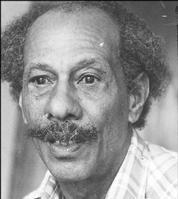
CARL ABRAHAMS, the veteran Jamaican painter, died peacefully at his home in St. Andrew last Sunday. He was 93 years old.
On hearing of his death, the National Gallery's curator, David Boxer, hailed Abrahams as "one of the true pillars of 20th century Jamaican art.
"He served his muse well," said Dr. Boxer, "and his many master works which he has left us will be admitted for generations to come as key monuments of the formative years of our art movement."
Born in Kingston on May 14, 1911, Carl Myrie Abrahams began his artistic life as a gifted and prolific draughtsman while still at school. He taught himself the rudiments of composition, colour, line and form through the careful perusal of books on the art of the 'Old Masters'. Frans Hals and Sir Frederick Leighton, the Victorian master, were special influences.
COMMERCIAL ARTIST
On leaving school in 1928, he began to make a living as a commercial artist and under the tutelage of Cliff Tyrell, as a cartoonist making his mark in the latter where wit and irony must coincide with a fluent and a good sense of characterisation. The pages of The Daily Gleaner, The Jamaica Times and Wisco Magazine attest to his early brilliance as a cartoonist.
In 1937, Abrahams met the renowned British Augustus John who was then painting in the island. John urged him to paint professionally, and this Carl Abrahams began to do, rather tentatively before World War II, but with added impetus after his return from services in the Royal Air Force in England, in 1944.
Like John Dunkley, the Jamaican master whom he most admired and who was an early influence, Abrahams was an individualist who avoided the structures established by the Institute of Jamaica for the training of artists and essentially taught himself to paint with the assistance of correspondence courses from England. A tentative oeuvre based on topical subjects followed. It was not until the mid-1950s, however, that he would begin to find his true mode of expression - ironic transformations of the great mythological and religious themes of the past and intensely personal fantasies, surreal records of contemporary events.
In the mid-'70s, he responded enthusiastically to the National Gallery curator's overtures for him to heighten his investigation of religious art and to expand his series on the final days of our Lord's ministry. Out of this collaboration was born the gallery's pivotal exhibition 'The Passion of Christ', which showed some 20 works by Abrahams. The wit and sheer inventiveness of the series, coupled to the devout sentiment of a true believer, marked Abrahams out as Jamaica and the Caribbean's finest religious painter. The exhibition, and the accompanying film utilising his paintings, played an important role in consolidating his reputation and his popularity soared in the wake of the exhibition.
He was also a master of what have been called "surreal fantasies" and in works like his 'Beheading of Maggydon' (1974) and 'Judgement Day' (1995), he submerged his resentment of the politics of the 70s in dense allegories of "destruction by divine intervention" that seemingly parodied the revelatory pronouncements of St. John. His most profound fantasy on the theme of what he perceived as "divisive politics" is his painting 'The Angels Are Weeping' (1977). Originally planned as a work depicting angels weeping over the dead Christ, the painting evolved, by emblematically presenting the angels as representatives of the racial groups of 'Out of Many, One People' Jamaica, as a threnody for the 'lost' paradise.
PROFOUNDLY MOVING WORK
It is these works and others which have generously flowed from his brush for the past half century, works like his many versions of the 'Last Supper', 'The Unveiling of the Statue of Simon Bolivar', his 'Hallelujah, Hallelujah, Hallelujah', his 'Adam and Waltz of the Horses' that have invested Jamaican art with a rare poetic iconography of startling richness, full of humour and irony but also profoundly moving and at times ecstatic.
His final decades saw few new developments in his work and he replicated many of his earlier paintings in copies and variations.
Carl Abrahams was the recipient of many national honours including the Order of Distinction and the Gold Musgrave Medal. He was also honoured by the National Gallery when he became the first artist to receive a full retrospective at the gallery. This was held 30 years ago, in 1975. In recent years, his master work, 'Woman, I Must be About My Father's Business', was loaned to the City of Edinburgh's 'Light of the World' exhibition commemorating the 2000th anniversary of the birth of Jesus Christ, while two of his religious works, were featured on Jamaican stamps marking the advent of the third millennium.
He is recognised by his contemporaries and younger artists as an individual whose work helped to define the Jamaican identity that is depicted in our special art form. He is undoubtedly one of our cultural icons and his paintings will continue to earn the admiration of future generations.
- Prime Minister
P.J. Patterson
The Institute of Jamaica is grateful for his seminal contribution to the national art movement, and generations yet to come
will continue to stand before his works displayed in the National Gallery and wonder at the power of this major Jamaican artist.
Institute of Jamaica
Carl Abrahams represents the finest quality of Jamaican creativity and artistry. He belongs on the canvas of Jamaican artists who finally embraced the flow and direction of their natural talent and embarked upon a life-long and life-giving career that was to have great impact on the cultural landscape of Jamaica and the world.
Ministry of Education, Youth
and Culture








